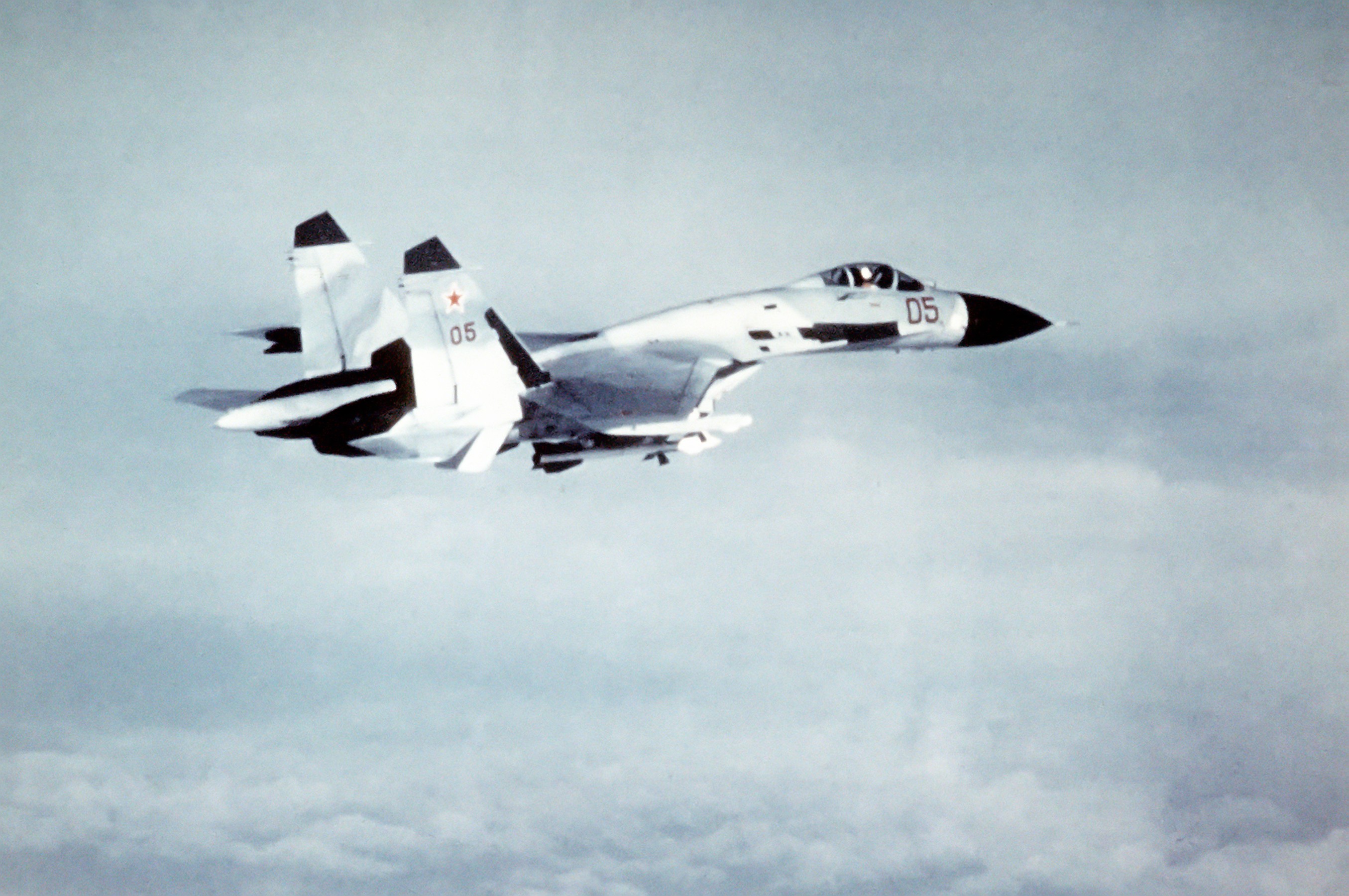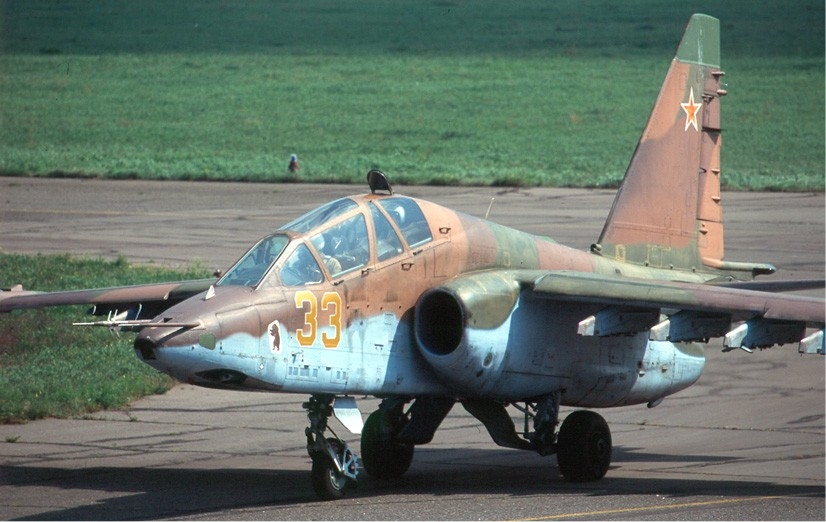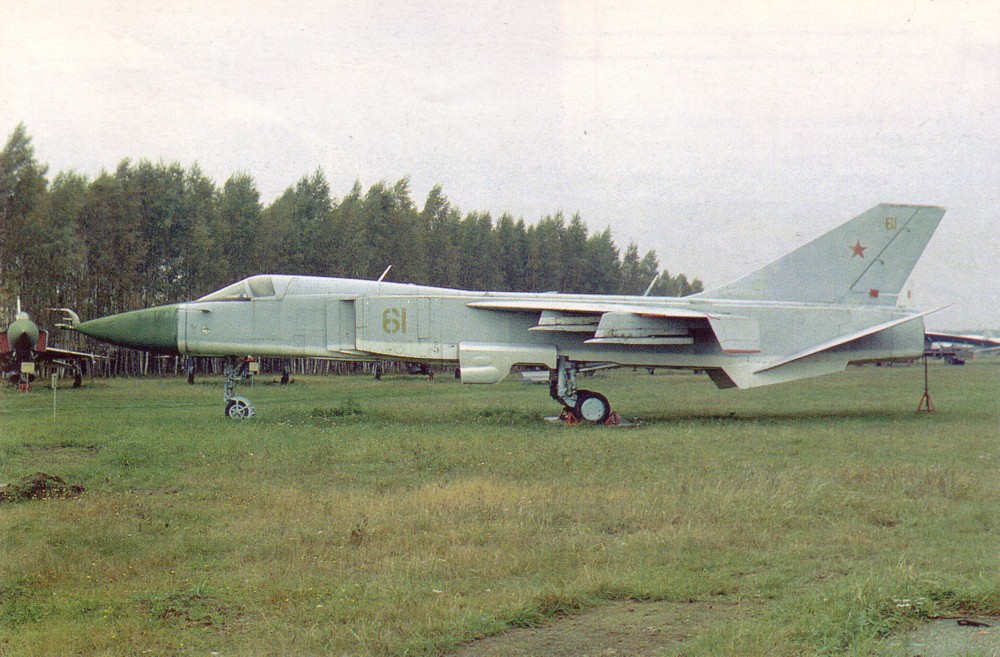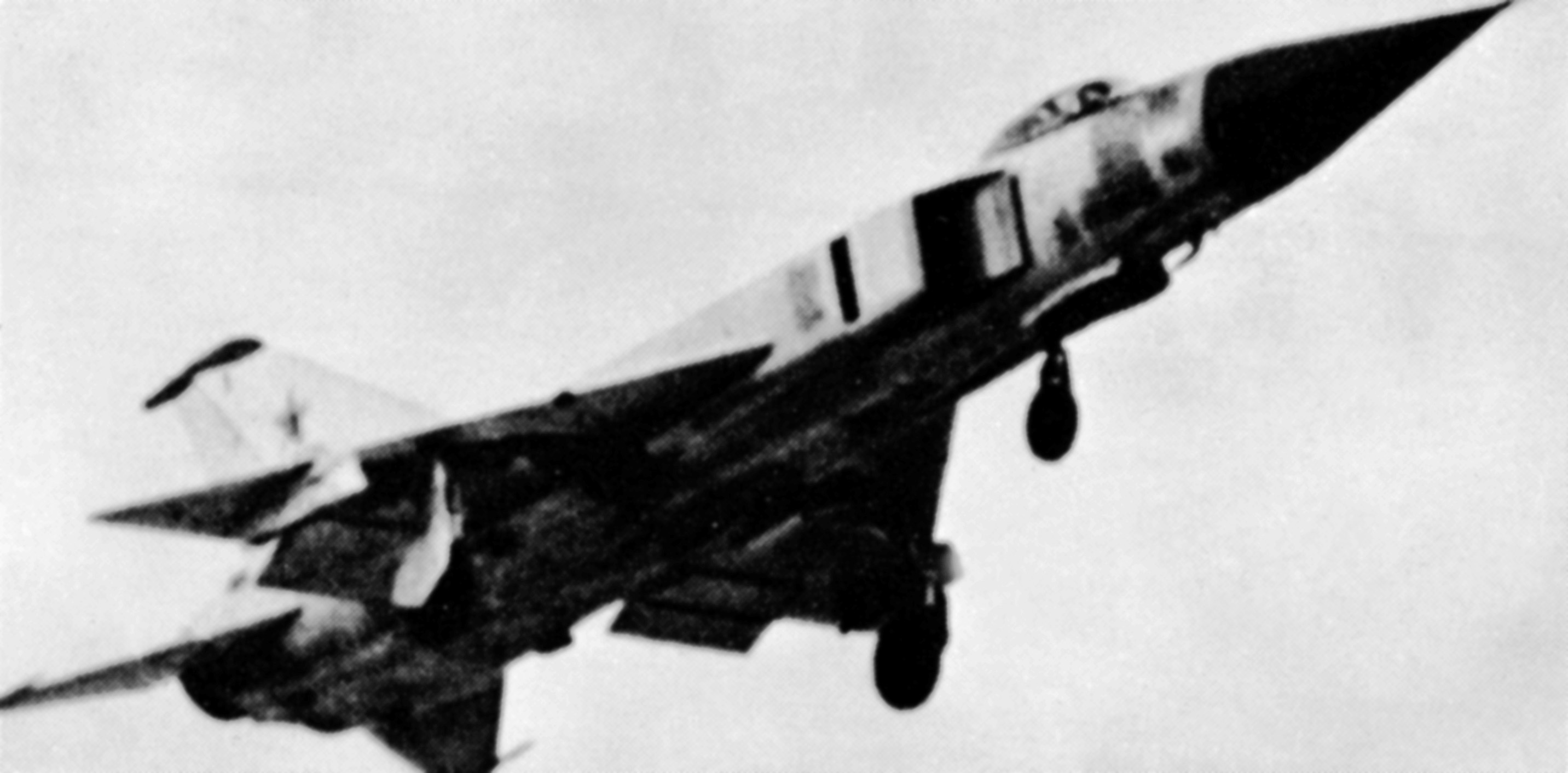|
Viktor Pugachev
Viktor Georgiyevich Pugachev () (born 8 August 1948 in Taganrog, Russian Soviet Federative Socialist Republic, RSFSR) is a retired Russian Air Force officer and a former Soviet test pilot who was the first to demonstrate the so-called Pugachev's Cobra manoeuvre to the general public in 1989, flying an Sukhoi Su-27, Su-27. The Gold medal of the Hero of the Soviet Union was awarded to him in the late 1980s. He graduated from the Yeysk Higher Military Order of Lenin Aviation School in 1970, test-pilot school in 1978 and the Moscow Aviation Institute in 1980. After two years with Gromov Flight Research Institute he joined OKB Sukhoi where he tested the Su-9, Su-15, Su-24, Su-25 and the Su-27. On 1 November 1989 he landed a Su-27K on an aircraft carrier for the first time in Soviet history. He became famous after his 1989 Su-27 demonstrations on the Paris Airshow. Pugachev is credited with first ever non-vertical take-off and landing (VTOL) from the aircraft carrier Soviet aircraft ... [...More Info...] [...Related Items...] OR: [Wikipedia] [Google] [Baidu] |
Taganrog
Taganrog (, ) is a port city in Rostov Oblast, Russia, on the north shore of Taganrog Bay in the Sea of Azov, several kilometers west of the mouth of the Don (river), Don River. It is in the Black Sea region. Population: Located at the site of an ancient Greek and medieval Italian colony, modern Taganrog was founded in 1698. Contested by various factions during World War I and the Russian Civil War, the city served as the temporary Soviet Ukrainian capital in 1918. Demographics History The history of the city goes back to the late Bronze Age–early Iron Age. Later, it became the earliest Ancient Greek colonies, Greek settlement in the northwestern Black Sea region and was probably mentioned by the Greek historian Herodotus as Emporium (antiquity), emporion Kremnoi (Κρήμνοι, meaning cliffs). It had contacts as well to the other Greek colonies around the Black Sea as well as to the indigenous communities of the hinterland. In the 13th century, Republic of Pisa, Pisan ... [...More Info...] [...Related Items...] OR: [Wikipedia] [Google] [Baidu] |
Order "For Merit To The Fatherland"
The Order "For Merit to the Fatherland" () is a state decoration of the Russian Federation. It was instituted on 2 March 1994 by Presidential Decree 442. Until the re-establishment of the Order of St. Andrew in 1998, it was the highest order of the Russian Federation. The order's status was modified on 6 January 1999 by Presidential Decree 19 and again on 7 September 2010 by Presidential Decree 1099. Statute of the Order The Order "For Merit to the Fatherland" is a mixed civilian and military order created in four classes. It is awarded for outstanding contributions to the state associated with the development of Russian statehood, advances in labour, peace, friendship and cooperation between nations, or for significant contributions to the defence of the Fatherland. The highest of the four classes is the Order I class, the lowest being the Order IV class. These classes are awarded sequentially from the IV to the I class. Persons awarded the Order For Service to the Fatherlan ... [...More Info...] [...Related Items...] OR: [Wikipedia] [Google] [Baidu] |
Su-27
The Sukhoi Su-27 (; NATO reporting name: Flanker) is a Soviet-origin twin-engine supersonic supermaneuverable fighter aircraft designed by Sukhoi. It was intended as a direct competitor for the large US fourth-generation jet fighters such as the Grumman F-14 Tomcat and McDonnell Douglas F-15 Eagle, with range, heavy aircraft ordnance, sophisticated avionics and high maneuverability. The Su-27 was designed for air superiority missions, and subsequent variants are able to perform almost all aerial warfare operations. It was designed with the Mikoyan MiG-29 as its complement. The Su-27 entered service with the Soviet Air Forces in 1985. The primary role was long range air defence against American SAC Rockwell B-1B Lancer and Boeing B-52G and H Stratofortress bombers, protecting the Soviet coast from aircraft carriers and flying long range fighter escort for Soviet heavy bombers such as the Tupolev Tu-95, Tupolev Tu-22M and Tupolev Tu-160. The Su-27 was developed ... [...More Info...] [...Related Items...] OR: [Wikipedia] [Google] [Baidu] |
Su-25
The Sukhoi Su-25 ''Grach'' ( ('' rook''); NATO reporting name: Frogfoot) is a subsonic, single-seat, twin-engine jet aircraft developed in the Soviet Union by Sukhoi. It was designed to provide close air support for Soviet Ground Forces. The first prototype made its maiden flight on 22 February 1975. After testing, the aircraft went into series production in 1978 in Tbilisi in the Georgian Soviet Socialist Republic. Early variants included the Su-25UB two-seat trainer, the Su-25BM for target-towing, and the Su-25K for export customers. Some aircraft were upgraded to the Su-25SM standard in 2012. The Su-25T and the Su-25TM (also known as the Su-39) were further developments, not produced in significant numbers. The Su-25, and the Su-34, were the only armoured, fixed-wing aircraft in production in 2007.Gordon and Dawes 2004. Su-25s are in service with Russia, other CIS members, and export customers. Production of the Su-25 ended in 2010 in Georgia. Attempts continue to be ma ... [...More Info...] [...Related Items...] OR: [Wikipedia] [Google] [Baidu] |
Su-24
The Sukhoi Su-24 (NATO reporting name: Fencer) is a supersonic, night fighter, all-weather tactical bomber developed in the Soviet Union. The aircraft has a variable-sweep wing, Twinjet, twin engines and a side-by-side seating arrangement for its crew of two. It was the first of the USSR's aircraft to carry an integrated digital Nav/attack system, navigation/attack system. The Su-24 started development in the early 1960s and first flew in 1967. It entered service in 1974 and production ceased in 1993. It remains in service with the Russian Aerospace Forces, Syrian Air Force, Ukrainian Air Force, Algerian Air Force and various other air forces to which it was exported. Development Background One of the conditions for accepting the Sukhoi Su-7, Sukhoi Su-7B into service in 1961 was the requirement for Sukhoi to develop an all-weather variant capable of precision air strikes. Preliminary investigations with ''S-28'' and ''S-32'' aircraft revealed that the basic Su-7 design was to ... [...More Info...] [...Related Items...] OR: [Wikipedia] [Google] [Baidu] |
Su-15
The Sukhoi Su-15 (NATO reporting name: Flagon) is a twinjet supersonic interceptor aircraft developed by the Soviet Union. It entered service in 1965 and remained one of the front-line designs into the 1990s. The Su-15 was designed to replace the Sukhoi Su-11 and Sukhoi Su-9, which were becoming obsolete as NATO introduced newer and more capable strategic bombers. Development Recognizing the limitations of the earlier Su-9 and Su-11 in intercepting the new Boeing B-52 Stratofortress, particularly in terms of radar and aircraft performance, the Sukhoi OKB quickly began the development of a heavily revised and more capable aircraft. A variety of development aircraft evolved, including the Sukhoi T-49, which shared the fuselage of the Su-9 (including its single engine), but used cheek-mounted intakes to leave the nose clear for a large radome for the RP-22 Oryol-D ("Eagle") radar (NATO "Skip Spin"), and the T-5, essentially a heavily modified Su-11 with a widened rear fuselage con ... [...More Info...] [...Related Items...] OR: [Wikipedia] [Google] [Baidu] |
Su-9
The Sukhoi Su-9 (Air Standardization Coordinating Committee, ASCC reporting name: Fishpot) is a single-engine, all-weather, missile-armed interceptor aircraft developed by the Soviet Union. Development The Su-9 emerged from aerodynamic studies by TsAGI, the Soviet aerodynamic center, during the Korean War, which devised several optimum aerodynamic configurations for jet fighters. The design first flew in 1956 in aviation, 1956 as the T-405 prototype. The Su-9 was developed at the same time as the Sukhoi Su-7, Su-7 "Fitter", and the West first saw both at the Tushino Aviation Day on June 24, 1956, where the Su-9 was dubbed Fitter-B. It entered service in 1959 in aviation, 1959. The total production of the Su-9 was about 1,100 aircraft. It is believed that at least some Su-9s were upgraded to Sukhoi Su-11, Su-11 "Fishpot-C" form. None were exported to any of the Soviet Union, USSR's client states nor to the Warsaw Pact nations. The remaining Su-9s and later Su-11s were retired d ... [...More Info...] [...Related Items...] OR: [Wikipedia] [Google] [Baidu] |
OKB Sukhoi
The JSC Sukhoi Company (, ) is a Russian aircraft manufacturer headquartered in Begovoy District, Northern Administrative Okrug, Moscow, that designs both civilian and military aircraft. Sukhoi was founded in the Soviet Union by Pavel Sukhoi in 1939 as the Sukhoi Design Bureau (OKB-51, design office prefix Su), and survived the dissolution of the Soviet Union. In February 2006, the Russian government merged Sukhoi with Mikoyan, Ilyushin, Irkut, Tupolev, and Yakovlev as a new company named United Aircraft Corporation.Russian Aircraft Industry Seeks Revival Through Merger ." ''.'' February 22, 2006 ... [...More Info...] [...Related Items...] OR: [Wikipedia] [Google] [Baidu] |
Yeysk Higher Military Order Of Lenin Aviation School
Yeysk () is a port and a resort town in Krasnodar Krai, Russia, situated on the shore of the Taganrog Gulf of the Sea of Azov. The town is built primarily on the Yeysk Spit, which separates the Yeya River from the Sea of Azov. Population: History In the 14th century, in this area was a Genoese colony with a port called Balzimachi (or Bacinaci), which is mentioned in Pratica della mercatura. Tsutsiev's Atlas shows a Yeyskoye at the head of the Yeya bay for 1763-1785 and a Yeysk somewhat south of the present location from 1829 to 1839. In 1783 it was involved in the Kuban Nogai Uprising. The town was founded in 1848 by Prince Mikhail Semyonovich Vorontsov in accordance with a royal order from the Tsar of Russia. Administrative and municipal status Within the framework of administrative divisions, Yeysk serves as the administrative center of Yeysky District, even though it is not a part of it.Reference Information #34.01-707/13-03 As an administrative division, it is, to ... [...More Info...] [...Related Items...] OR: [Wikipedia] [Google] [Baidu] |
Russian Air Force
The Russian Air Force () is a branch of the Russian Aerospace Forces, the latter being formed on 1 August 2015 with the merging of the Russian Air Force and the Russian Aerospace Defence Forces. After the dissolution of the Soviet Union, the reborn Russian armed forces began to be created on 7 May 1992 following Boris Yeltsin's creation of the Ministry of Defence (Russia), Ministry of Defence. However, the Russian Federation's air force can trace its lineage and traditions back to the Imperial Russian Air Service (1912–1917) and the Soviet Air Forces (1918–1991). History The Russian Air Force, officially established on 12 August 1912, as part of the Imperial Russian Air Service, has a long and complex history. It began as one of the earliest military aviation units globally, although its early years saw slow development due to the constraints of World War I. After the Russian Revolution, Russian Revolution of 1917, the air service was reorganised under the Soviet regime, ev ... [...More Info...] [...Related Items...] OR: [Wikipedia] [Google] [Baidu] |
Russian Soviet Federative Socialist Republic
The Russian Soviet Federative Socialist Republic (Russian SFSR or RSFSR), previously known as the Russian Socialist Federative Soviet Republic and the Russian Soviet Republic, and unofficially as Soviet Russia,Declaration of Rights of the laboring and exploited people, article I. was a socialist state from 1917 to 1922, and afterwards the largest and most populous Republics of the Soviet Union, constituent republic of the Soviet Union (USSR) from 1922 to 1991, until becoming a Declaration of State Sovereignty of the Russian SFSR, sovereign part of the Soviet Union with priority of Russian laws over Union-level legislation in 1990 and 1991, the last two years of the existence of the USSR.The Free Dictionary Russian Soviet Federated Socialist Republic< ... [...More Info...] [...Related Items...] OR: [Wikipedia] [Google] [Baidu] |
Order Of The Badge Of Honour
The Order of the Badge of Honour () was a civilian award of the Soviet Union. It was established on 25 November 1935, and was conferred on citizens of the USSR for outstanding achievements in sports, production, scientific research and social, cultural and other forms of social activity; for promotion of economic, scientific, technological, cultural and other ties between the USSR and other countries; and also for significant contribution to basic and applied research. The order was awarded 1,574,368 times. The "Order of the Badge of Honour" was replaced by the "Order of Honour" () by a Decree of the Presidium of the USSR on 28 December 1988. Following the USSR dissolution, it was replaced by the " Order of Honour" of Russia, established by Presidential Decree no. 442 of 2 March 1994.Ельцин, Б.Н. (2 марта 1993 г.)"Указ Президента Россиийской Федерации о госудаственных наградах Российской Фед� ... [...More Info...] [...Related Items...] OR: [Wikipedia] [Google] [Baidu] |







